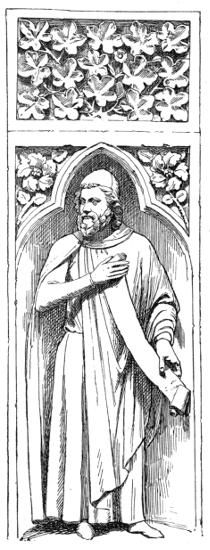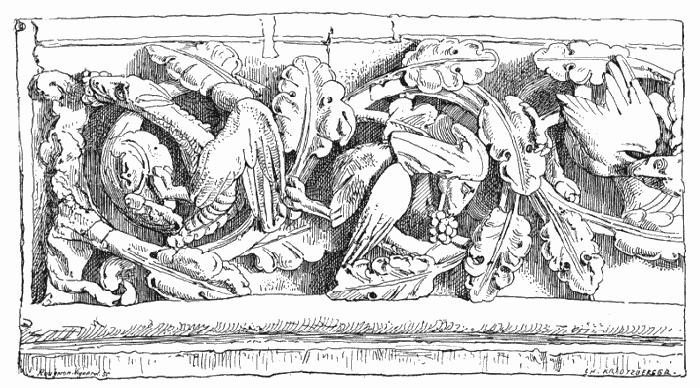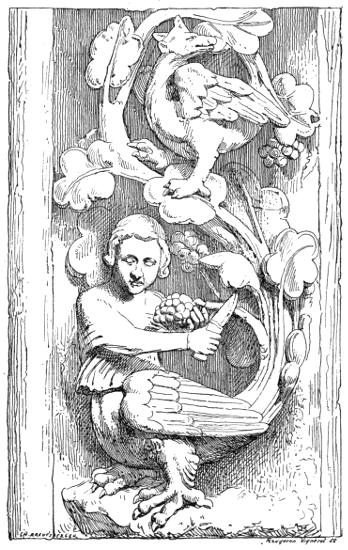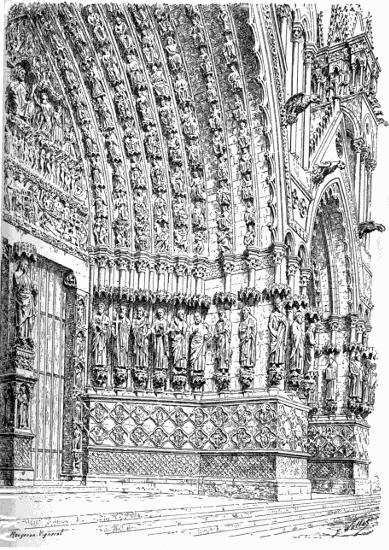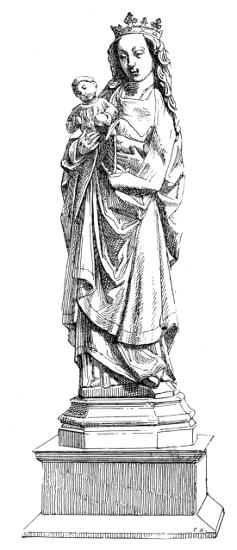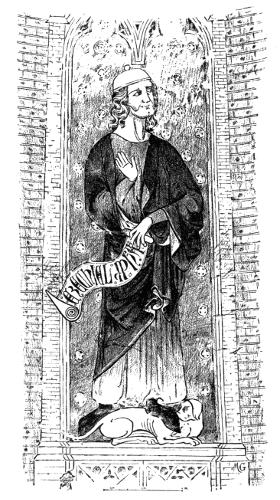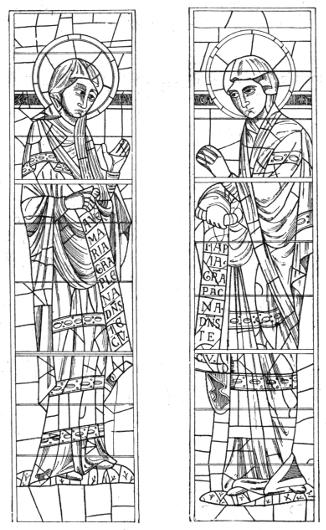Other documents randomly have different content
The architects of the thirteenth century were pre-eminently the children of their generation. Ignoring their Latin descent they followed in the paths of the innovators so far as monumental structure was concerned; but they in their turn inaugurated a new departure by abandoning the Byzantine convention in statuary and sculptured ornament which had prevailed throughout the preceding century, in favour of the more ancient Roman tradition. In this one respect they made a salutary return upon those antique principles which they afterwards definitively abandoned.
96. RHEIMS CATHEDRAL. STATUES OF WEST FRONT
97. RHEIMS CATHEDRAL. INTERIOR OF PRINCIPAL DOOR. STATUE AND ORNAMENT
98.
The influence of Roman art upon French mediæval sculpture is unquestionable. Its course may be traced through the relations existing between North and South long before the Crusades, principally by means of the great religious communities, and even more manifestly in the countless monuments raised in Gaul on Roman models, or in those constructed by Gallo-Romans for several centuries. Many of these survived the incursions of the barbarians.
The origin of ornamental sculpture is no less venerable. Superficially, it would seem to have drawn its inspiration mainly from the Romanesque epoch; but according to modern savants[35] its source must be looked for in much remoter periods. Oriental art, imported into Scandinavia, and there
RHEIMS CATHEDRAL. INTERIOR OF PRINCIPAL DOOR. STATUE AND ORNAMENT
barbarised, was introduced into Ireland in the early centuries of our era. The Irish monks, whose power was very great, and who seem to have been the principal agents in the Renascence of the days of Charlemagne, created, or at any rate greatly influenced Carlovingian art by their manuscripts and miniatures. From Carlovingian art that of the so-called Romanesque period was born, and this was in its turn the parent of the ornamental sculpture of the thirteenth century. In the admirably decorative character of this art we recognise the influence of an ancient tradition handed on from generation to generation, to be finally rejuvenated, invigorated, and transformed as to detail by a close study of nature, precisely as had happened in the allied development of statuary.
[35] M. A. de Montaiglon, Professor at the École des Chartes.
The architects of the Ile-de-France, like those of Rheims, assimilated the principles of the new art with the supple skill which characterised them, such assimilation bearing rich fruit at Notre Dame de Paris in the sculptured figures of the west porch, and no less in their accessory ornaments.
99. NOTRE DAME DE PARIS. PRINCIPAL DOOR. RUNNING LEAF PATTERN
A most instructive comparative study is furnished by the north and south porches of Chartres Cathedral. Here we find, in one building, examples of sculptures inspired by the hieratic tradition of Byzantium, and of those which had been transformed and naturalised by a return to antique ideals.
100. NOTRE DAME DE PARIS. RUNNING LEAF PATTERN ON ARCHIVOLTS OF NORTH DOOR
101. CHARTRES CATHEDRAL. STATUES OF THE NORTH PORCH
At Amiens again certain of the sculptures were influenced by the new principles. But in the greater part there is a prodigality of motive and looseness of execution which indicate decline no less surely than the mistaken ingenuity of the structural details.
102. CHARTRES CATHEDRAL. STATUES OF THE SOUTH PORCH
Mediæval sculpture followed the fortunes of architecture, both in its rise and fall. In its first beginnings it was characterised by a purity of style not unworthy of Rome in her most glorious days, but rapidly losing touch with the antique ideal, it lost measure and proportion in its development. The wise laws of simplicity, essential to all greatness in art, were set aside in favour of an unruly exuberance which ran riot in details, and was the immediate cause of a decline perceptible even in the fourteenth century, and absolute in the fifteenth. "Sculpture was at its zenith. We are astounded by the activity and fertility of thirteenth-century artists, who peopled façades and embrasures with figures from seven to ten feet in height, and animated every tympanum with countless statuettes. The façade of Notre Dame, by no means one of the richest, has sixty-eight
colossal statues, for the most part of the highest excellence; at Chartres and at Amiens there are over a hundred to each porch. The famous figure of Christ at Amiens is a masterpiece; bas-reliefs work out the details of the main subject, and enrich the story with innumerable pictures of amazing vigour and originality."
103. AMIENS CATHEDRAL. CENTRAL PORCH OF WEST FRONT
104. AMIENS CATHEDRAL. STATUES IN THE SOUTH PORCH
The favourite themes of the thirteenth century had something in common with those of the Romanesque epoch, though there is a sensible difference of treatment and considerable progress in composition, which exhibited more of taste and learning and less of eccentricity. But the satiric power and delight in caricature of our forefathers still demanded an outlet. These found expression in many a caustic gibe at clergy, princes, and rich burghers, and took substance in many a quaint gargoyle. A luxuriant system of ornamentation, adapted from the vegetable kingdom, was auxiliary to statuary. The main subject was enframed by it, or relieved against it; while often the composition itself was enriched by its introduction to complete the decorative effect. Or
105. AMIENS CATHEDRAL. CHOIR STALLS. CARVED ORNAMENT
such a system of decoration was the only sculpturesque motive employed; it was then used with the utmost elaboration, and developed at the expense of statuary. Such was the case in Burgundy and Normandy, in which provinces the latter art was of slow growth. The Byzantine character of the scrolls, carved bands, and fantastic foliage of Romanesque art disappeared; ornament took on a new independence, and began to seek its types among native plant forms.
The carved leafage (Fig. 106) of the cloister arcades in the Abbey of Mont St. Michel strikingly illustrate this departure. The very plants which inspired the thirteenth-century sculptors still flourish at the foot of the ancient abbey walls.
106. ABBEY OF MONT ST. MICHEL. CLOISTERS OF THE THIRTEENTH CENTURY. CARVED ORNAMENT OF INTERIOR SPANDRILS
107. WOODEN STATUETTE (HEIGHT 23⅝ IN.)
THIRTEENTH CENTURY. ATELIERS DE LA CHAISE DIEU, AUVERGNE
108. IVORY STATUETTE (HEIGHT 9⅞ IN.) THIRTEENTH CENTURY. SCHOOL OF PARIS
Thus the flora of our own fields was applied in lithic form to the elements of our church architecture. But the breadth proper to architectural sculpture was still preserved by means of ingenious combinations.
It was not until the fourteenth and fifteenth centuries that the imitation of natural forms became servile, tedious, and over-minute, and that the beauty of the whole was sacrificed to exaggerated faithfulness of detail.[36]
[36] Anthyme St. Paul, Histoire Monumentale de la France; Paris, Hachette and Co., 1884.
108A. IVORY STATUETTE (HEIGHT 9½ IN.) FIFTEENTH CENTURY. SCHOOL OF PARIS
It should be noted that the decadence which manifested itself in monumental sculpture was far less rapid in the more intimate art which may be distinguished as imagery. In the thirteenth and fourteenth centuries all sculptors were image-makers; but towards the close of the latter, and during the fifteenth, the term was specially applied to carvers of images in wood, ivory, etc. Art still flourished in their ateliers in all its beauty, notably that of the goldsmiths, who carved images in high or low relief in precious metals, and who, thanks to the severely paternal regulations of the maîtrise, were enabled to bring French decorative art to the highest degree of perfection. The beautiful carved wooden stalls of Amiens, Auch, and Albi, to name but the most famous, testify to the vigorous talent of the fourteenth and fifteenth-century image-carvers.
109. WOODEN STATUETTE (HEIGHT 10 IN.) FOURTEENTH CENTURY. SCHOOL OF PARIS
110. IVORY DIPTYCH (HEIGHT 6⅜ IN.) FOURTEENTH CENTURY. SCHOOL OF PARIS
110A. IVORY DIPTYCH (HEIGHT 2¾ IN.) FOURTEENTH CENTURY. SCHOOL OF THE ILE-DEFRANCE
Flemish ateliers, which were kept up by the severe rules of the guilds, exercised a salutary influence upon the Burgundian craftsmen. This is more especially true of the great workshops of Antwerp and of Brussels, and perhaps also of those of Southern Germany. Burgundian influences reacted in their turn upon the artists of the Ile-de-France, notably in Paris (that brilliant centre of all artistic activities in the fourteenth century), and stirred them to emulation. The union of these various elements brought about the revival of the fine tradition of the thirteenth century, and towards the close of the fifteenth century paved the way for a French Renascence, which heralded that more famous movement of the sixteenth, the credit of which is usually given to the Italians, who, however, such was the infatuation of the times, contributed rather to the debasement than to the regeneration of French national art.
111. IVORY DIPTYCH (HEIGHT 4¾ IN.) FOURTEENTH CENTURY. SCHOOL OF PARIS
111A. IVORY PLAQUE (HEIGHT 611/16 IN.) COVER OF AN EVANGELIUM. FOURTEENTH CENTURY. SCHOOL OF THE ILE-DE-FRANCE (SOISSONS)
112 HEAD IN SILVER GILT REPOUSSÉ HALF-LIFE SIZE
THIRTEENTH CENTURY. ATELIERS OF THE GOLDSMITH'S GUILD OF PARIS
113. GROUP CARVED IN WOOD (HEIGHT 10¼ IN.)
FIFTEENTH CENTURY. SCHOOL OF ANTWERP
The remarkable sculptures that owe their origin to the ateliersof Antwerp are distinguished by one of the quarterings of the civic arms, a severed hand burnt in with a red-hot iron. Those of Brussels are branded in like fashion. The images of wood, ivory, and vermeil, that we figure as illustrating the art of the image-carvers from the thirteenth to the fifteenth century, show that the old tradition was still cherished in this community. Their artists were so far swayed by iconographic convention that a certain hieratic sentiment is perceptible in their works; but this is never allowed to outweigh fitness of action and expression, and their masterpieces are so instinct with taste and delicacy, composed with so much skill and executed with such freedom, that they are the admiration of modern artists.[37]
[37] The statuettes, diptychs, etc., in wood, ivory, and vermeil, or silvergilt, figured from No. 107 to No. 115, belong to the author.
114. WOODEN STATUETTE, PAINTED AND GILDED (HEIGHT 1911/16 IN.) FIFTEENTH CENTURY. SCHOOL OF BRUSSELS
115. WOODEN STATUETTE, PAINTED AND GILDED (HEIGHT 1911/16 IN.) SIXTEENTH CENTURY. SCHOOL OF MUNICH
These essentially French qualities they owe, primarily, of course, to the genius of their creators, but in a scarcely inferior degree to the fostering care of the maîtrises, institutions which only require a certain modification by the progressive leaven of today, to become models for the imitation of all whose function it is to develop national art.
CHAPTER XII PAINTING
The origin of painting dates from remote antiquity, and the art had already passed through many developments before it was applied by Gothic architects to the decoration of their buildings.
"In the thirteenth century the architectonic painting of the Middle Ages reached its apogee in France. The painted windows, the vignettes of manuscripts, and the mural decorations of this period all denote a learned and finished art, and are marked by a singular harmony of tones, and a corresponding harmony with architectural forms. It is beyond question that this art was developed in the cloister, and was a direct product of Græco-Byzantine teachings."[38]
[38] Viollet-le-Duc, Dictionnaire raisonné, vol. vii.
From the archæological point of view, however, it is important to bear in mind the considerable influence exercised upon continental art by the manuscripts and miniatures of Irish monks, so early as the reign of Charlemagne.
116. PAINTINGS IN CAHORS CATHEDRAL. HORIZONTAL PROJECTION OF THE CUPOLA WITH FORESHORTENED FIGURES AND THEIR ARCHITECTURAL FRAMEWORK
Towards the close of the twelfth century sculpture and painting alike entered on a new phase, resulting from that process of architectural evolution we have been considering. The hieratic tradition was set aside for the direct teaching and inspiration of nature. But as the mastery of the painter increased, the mural spaces available for the application of his new methods diminished
rapidly, till, by the thirteenth century, the only wall surfaces left to him were those beneath the windows, and some few triangular spaces in the vault, where the interlacing network of arches became gradually closer and closer. Finding themselves thus practically excluded from the new Gothic buildings, the painters of the day turned their attention with entire success to the decoration of ancient monuments by the new naturalistic methods. The domes of great abbey churches such as St. Front (Périgueux) offered immense bare surfaces, the concave forms of which they utilised with extraordinary skill, adorning them with compositions in which figure and ornament are so adroitly combined, that they seem to be of normal proportions, in spite of their really colossal size (Fig. 117).
117. PAINTING IN CAHORS CATHEDRAL. FRAGMENT OF ONE OF THE EIGHT SECTORS OF THE CUPOLA. THE PROPHET EZEKIEL
Thanks to a discovery of mural paintings made in the Cathedral of Cahors in 1890, of the greatest archæological importance, we are able to verify these statements.
During the progress of certain works undertaken for the preservation of the two domes, some paintings of great interest were laid bare on the removal of several coats of whitewash from the western cupola. Traces of similar decoration were found on the eastern cupola and its pendentives, but these it was found impossible to preserve, the action of the air causing them to peel at once from the surfaces. But the western composition is intact, and though the brilliance of the colour has no doubt suffered from time, we can still appreciate the learning, vigour, and firmness of hand perceptible in the design, which is outlined in black.
This western cupola, which is ovoid, and some fifty-three feet in diameter, like that of the east, is divided by its pictorial scheme into eight sectors, separated by wide bands of boldly-designed fruits and flowers. Fig. 116 gives an exact idea of the general arrangement. Eight colossal figures of prophets, varying in height from fifteen to sixteen feet approximately, form the chief motives of the decoration. David, the prophet king, and the four great prophets: Daniel to the left of David; then in order, Jeremiah, Isaiah, and Ezekiel on the right, towards the choir of the church, and the three minor prophets—Jonah, Esdras, and Habakkuk are painted in modulated tones, the dark outline forming a setting, on a background varying from tawny to deep red. The figures are enframed in a firmly-drawn architectural setting. This architecture is painted in gray against the masonry, the courses of which are indicated by double lines of brown upon the pale ochre of the general surface. Each prophet holds a phylactery or banderole inscribed with his name in beautiful thirteenth-century characters.
The floriated bands which divide the sectors terminate above in a circular frieze surrounding the crown of the cupola. The latter represents a starry sky, the centre painted with the apotheosis of St. Stephen, the patron of the cathedral. The frieze is painted with scenes from the trial and stoning of the Saint; the life-size figures are full of expression and grouped with great variety. In these paintings there are evident leanings towards the naturalistic evolution; and though the figures of the prophets are still hieratic in certain respects, the poses, heads, and details all point to evident research in the matter of physiognomy. This research is carried very far in the figures of the circular frieze, where the hands have evidently been carefully studied from nature.
118. PAINTINGS IN CAHORS CATHEDRAL. FRAGMENT OF THE CENTRAL FRIEZE OF THE CUPOLA
Technically speaking, these paintings are not frescoes. "The medium employed seems to have been egg, the white and yolk mixed, and the method very analogous to that of water-colour painting.... The red tones were laid over a bed of deep orange, the effect being one of extraordinary vigour and brilliance, taking into account the means at command. The use of a prepared ground was systematic, and was resorted to whenever intensity of the tones or
colour effects was desired. Evident efforts in the direction of modelling are noticeable, though these have been neutralised to a great extent by a lack of concentration in the lights, and if it were not for the thick outline in which each figure is set, there would be much in common between the methods of these paintings and those renderings of diffused light affected by our modern plein-airistes. The general tone is that of the simpler paintings of the thirteenth century, that is to say, of those in which no gold was used. The effect is warm and brilliant, the dominant hue orange, heightened by reds of various tints."[39]
[39] From the technical notes of M. Gaïda.
According to the archæological records derived from various works of the historians of Le Quercy, these paintings in the west cupola of Cahors were carried out under the direction of the Bishops Raymond de Cornil, 1280-93, Sicard de Montaigu, 1294-1300, Raymond Panchelli,[40] 1300-1312, or Hugo Geraldi, 1312-16, the friend of Pope Clement V. and of Philip IV. of France, who was burnt alive at Avignon, or perhaps even of Guillaume de Labroa, 1316-24, whose residence was at Avignon, and who governed the diocese of Cahors through a procurator. From this period onwards there was no further question of decorative works, the successors of these bishops being fully occupied in maintaining the struggle against the English invaders.
[40] Raymond Panchelli, or Raymond II., who in 1303 began to build the Bridge of Valentré at Cahors.
It seems reasonable therefore to infer that the Cahors paintings date either from the end of the thirteenth century or the beginning of the fourteenth. In any case, these decorations are of very great artistic merit, and of the highest interest as an unique example of French decorative art at the finest period of the thirteenth century, when Gothic architecture had reached its apogee, and was producing masterpieces which served as models for contemporary artists, and even more notably, for those of the early fourteenth century.
That vigilant guardian of our beautiful cathedrals and historic monuments, the Administration des Cultes, has taken measures which do it infinite honour in this matter. No attempt has been made to restore the paintings, but all necessary steps have been taken to ensure their preservation as they stand, so as to leave intact the archæological value of these convincing witnesses to the genius of our French mediæval painters.
The mural spaces available for fresco decoration having been gradually suppressed, and decorative painting limited to the illumination of certain subordinate members of the structure, the mediæval artists began to apply themselves to the decoration of the great screens of glass which, with their sculptured framework of stone, now filled the entire spaces between the piers. In this new art, or rather this incarnation of the spirit of decoration under a new form, we find a fresh illustration of that supple assimilative genius which already distinguished the French artist.
119, 120. PAINTED WINDOWS OF THE EARLY TWELFTH CENTURY. FROM ST. RÉMI AT RHEIMS[41]
[41] Drawings lent by M. Ed. Didron, painter upon glass.
"It is in the nature of the material used, that painted windows should greatly affect the character of the building they decorate. If their treatment is injudicious, the intended architectural effect may be greatly modified; if, on the other hand, they are intelligently applied, they tend to bring out the beauty of structural surroundings.... As is the case with all architectonic painting, stained glass demands
simplicity in composition, sobriety in execution, and an avoidance of naturalistic imitation. It should aim neither at illusion nor perspective. Its scheme of colour should be frank, energetic, comprising few tints, yet producing a harmony at once sumptuous and soothing, which should compel attention, but seeks not to engross it to the detriment of the setting. Like a mural mosaic, an Eastern carpet, or the enamelled goldsmith's work of the twelfth and thirteenth centuries, a truly decorative window has no affinities with a picture, a scene or landscape gazed at from an open window, where the interest concentrates itself upon a particular point, and where the illumination is not equally diffused throughout. The fundamental law of decorative painting rests on a convention the aim of which is the satisfaction of the eye, which finds its pleasure to a far greater degree in the logical decoration of some structural or useful object than in its realisation of natural phenomena. Between painted windows and pictures a great gulf is fixed; and the modern school, the heir of the Italian Renascence, seeking to bridge it over, has seduced decorative art from the safe paths of sound judgment." [42]
[42] Le Vitrail à l'Exposition de 1889, by Ed. Didron; Paris, 1890.
Welcome to our website – the perfect destination for book lovers and knowledge seekers. We believe that every book holds a new world, offering opportunities for learning, discovery, and personal growth. That’s why we are dedicated to bringing you a diverse collection of books, ranging from classic literature and specialized publications to self-development guides and children's books.
More than just a book-buying platform, we strive to be a bridge connecting you with timeless cultural and intellectual values. With an elegant, user-friendly interface and a smart search system, you can quickly find the books that best suit your interests. Additionally, our special promotions and home delivery services help you save time and fully enjoy the joy of reading.
Join us on a journey of knowledge exploration, passion nurturing, and personal growth every day!












